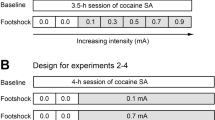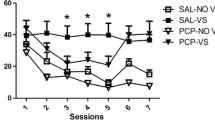Abstract
Phencyclidine (PCP; 2.5 or 5.0 mg/kg) potentiated the effects of rewarding hypothalamic brain stimulation, causing parallel leftward shifts of the functions that relate rate of responding to stimulation frequency. Thus, like a number of other drugs of abuse, PCP lowered the “dose” of stimulation required to maintain responding at a given criterion. No progressive changes in the reward-potentiating effects of PCP were evident when the rats were tested once per week for 8 weeks; there was neither tolerance nor sensitization to the initial rewarding properties of PCP. However, in subsequent locomotor tests rats appeared to be already sensitized to PCP; this raises the possibility that the electrical stimulation of the lateral hypothalamus itself maximally sensitized the animals to the stimulant effects of the drug.
Similar content being viewed by others
References
Anis NA, Berry SC, Burton NR, Lodge D (1983) The dissociative anaesthetics, ketamine and phencyclidine, selectively reduce excitation of central mammalian neurones by N-methyl-aspartate. Br J Pharmacol 102:565–575
Balster RL, Woolverton WL (1980) Continuous-access phencyclidine self-administration by Rhesus monkeys leading to physical dependence. Psychopharmacology 70:5–10
Barr GA, Paredes W, Bridger WH (1985) Place conditioning with morphine and phencyclidine: dose dependent effects. Life Sci 36:363–368
Bauco P, Wang Y, Wise RA (1991) Effect of repeated nicotine on lateral hypothalamic intracranial self-stimulation. IBRO Abstr 3:420
Carboni E, Imperato A, Perezzani L, Di Chiara G (1989) Amphetamine, cocaine, phencyclidine and nomifensine increase extracellular dopamine concentrations preferentially in the nucleus accumbens of freely moving rats. Neuroscience 28:653–661
Carlsson A (1988) The current status of the dopamine hypothesis of schizophrenia. Neuropsychopharmacology 1:179–186
Colle LM, Wise RA (1988) Effects of nucleus accumbens amphetamine on lateral hypothalamic brain stimulation reward. Brain Res 459:356–360
Collins RJ, Weeks JR, Cooper MM, Good PI, Russell RR (1984) Prediction of abuse liability of drugs using IV self-administration by rats. Psychopharmacology 82:6–13
Corbett D (1989) Possible abuse potential of the NMDA antagonist MK-801. Behav Brain Res 34:239–246
Crider R (1986) Phencyclidine: changing abuse patterns. NIDA Res Monogr 64:163–173
Di Chiara G, Imperato A (1988) Drugs abused by humans preferentially increase synaptic dopamine concentrations in the mesolimbic system of freely moving rats. Proc Natl Acad Sci USA 85:5274–5278
Esposito RU, Kornetsky C (1977) Morphine lowering of self-stimulation thresholds: lack of tolerance with long-term administration. Science 195:189–191
Fram DH, Stone N (1986) Clinical observations in the treatment of adolescent and young adult PCP abusers. NIDA Res Monogr 64:252–260
Frank RA, Martz S, Pommering T (1988) The effect of chronic cocaine on self-stimulation train-duration thresholds. Pharmacol Biochem Behav 29:755–758
Freeman AS, Bunney BS (1984) The effects of phencyclidine andN-allynormetazocine on mid-brain dopamine neuronal activity. Eur J Pharmacol 104:287–293
French ED, Ceci A (1990) Non-competitiveN-methyl-d-aspartate antagonists are potent activators of ventral tegmental A10 dopamine neurons. Neurosci Lett 119:159–162
Gallistel CR, Karras D (1984) Pimozide and amphetamine have opposing effects in the reward summation function. Pharmacol Biochem Behav 20:73–77
Gallistel CR, Freyd G (1987) Quantitative determination of the effects of catecholaminergic agonists and antagonists on the rewarding efficacy of brain stimulation. Pharmacol Biochem Behav 26:731–741
Gerhardt GA, Pang K, Rose GM (1987) In vivo electrochemical demonstration of the presynaptic actions of phencyclidine in rat caudate nucleus. J Pharmacol Exp Ther 241:714–721
Glickman SE, Schiff BB (1967) A biological theory of reinforcement. Psychol Rev 74:81–109
Hernandez L, Auerbach S, Hoebel BG (1988) Phencyclidine (PCP) injected into the nucleus accumbens increases extracellular dopamine and serotonin as measured by microdialysis. Life Sci 42:1713–1723
Horger BA, Shelton K, Schenk S (1990) Preexposure sensitizes rats to the rewarding effects of cocaine. Pharmacol Biochem Behav 37:707–711
Imperato A, Scrocco MG, Bacchi S, Agelucci L (1990) NMDA receptors and in vivo dopamine release in the nucleus accumbens and caudatus. Eur J Pharmacol 187:555–556
Iwamoto ET (1986) Place-aversion conditioned by phencyclidine in rats: development of tolerance and pharmacological antagonism. Alcohol Drug Res 6:265–276
Johnson KM, Jones SM (1990) Neuropharmacology of phencyclidine: basic mechanisms and therapeutic potential. Annu Rev Pharmacol Toxicol 30:707–730
Kalivas PW, Stewart J (1991) Dopamine transmission in the initiation and expression of drug- and stress-induced sensitization of motor activity. Brain Res Rev 16:223–244
Kelley KL, Reid LD (1977) Addictive agents and intracranial stimulation: morphine and thresholds for positive reinforcement. Bull Psychonom Soc 10:298–300
Kornetsky C, Esposito RU (1979) Euphorigenic drugs: effects on the reward pathways of the brain. Fed Proc 38:2473–2476
Lett BT (1989) Repeated exposures intensify rather than diminish the rewarding effects of amphetamine, morphine, and cocaine. Psychopharmacology 98:357–362
Liebman JM (1983) Discriminating between reward and performance: a critical review of intracranial self-stimulation methodology. Neurosci Biobehav Rev 7:45–72
Mendelsohn LG, Kalra V, Johnson BG, Kerchner GA (1985) Sigma opioid receptor: characterization and co-identity with the phencyclidine receptor. J Pharmacol Exp Ther 233:597–602
Miliaressis E, Rompré P-P, Laviolette PP, Phillipe L, Coulombe D (1986) The curve-shift paradigm in self-stimulation. Physiol Behav 37:85–93
Nabeshima T, Fukaya H, Yamaguchi K, Ishikawa K, Furukawa H, Kameyama T (1987) Development of tolerance and supersensitivity to phencyclidine in rats after repeated administration of phencyclidine. Eur J Pharmacol 135:23–33
Piazza PV, Deminiere JM, le Moal M, Simon H (1990) Stress-and pharmacologically-induced behavioral sensitization increases vulnerability to acquisition of amphetamine self-administration. Brain Res 514:22–26
Predy PA, Kokkinidis L (1984) Sensitization to the effects of repeated amphetamine administration on intracranial self-stimulation: evidence for changes in reward process. Behav Brain Res 13:251–259
Reid AA, Monn JA, Jacobson AE, Rice KC, Rothman RB (1990) Pseudoallosteric modulation by (+)-MK-801 of NMDA-coupled phencyclidine binding sites. Life Sci 46: PL-77–PL-82
Robinson TE, Becker JB (1986) Enduring changes in brain and behavior produced by chronic amphetamine administration: a review and evaluation of animal models of amphetamine psychosis. Brain Res Rev 11:157–198
Rompré P-P, Wise RA (1989) Opioid-neuroleptic interaction in brainstem self-stimulation. Brain Res 477:144–151
Schaefer GJ, Michael RP (1990) Interactions of naloxone with morphine, amphetamine, and phencyclidine on fixed interval responding for intracranial self-stimulation in rats. Psychopharmacology 102:263–268
Schneirla, TC (1959) An evolutionary and developmental theory of biphasic processes underlying approach and withdrawal. In: Jones MR (ed) Nebraska Symposium on Motivation. University of Nebraska Press, Lincoln, pp 1–42
Walker JM, Bowen WD, Walker FO, Matsumoto RR, De Costa B, Rice KC (1990) Sigma receptors: biology and function. Pharmacol Rev 42:355–402
Wise RA, Bauco P, Carlezon WA Jr, Trojniar W (1992) Self-stimulation and drug reward mechanisms. Ann NY Acad Sci 654:192–198.
Wise RA, Bozarth MA (1987) A psychomotor stimulant theory of addiction. Physiol Rev 94:469–492
Wise RA, Munn E (1993) Effects of repeated amphetamine injections on lateral hypothalamic brain stimulation reward and subsequent locomotion. Behav Brain Res (in press)
Wise RA (1980) Action of drugs of abuse on brain reward systems. Pharmacol Biochem Behav 13 [suppl. 3]: 213–223
Author information
Authors and Affiliations
Rights and permissions
About this article
Cite this article
Carlezon, W.A., Wise, R.A. Phencyclidine-induced potentiation of brain stimulation reward: acute effects are not altered by repeated administration. Psychopharmacology 111, 402–408 (1993). https://doi.org/10.1007/BF02253528
Received:
Revised:
Issue Date:
DOI: https://doi.org/10.1007/BF02253528




